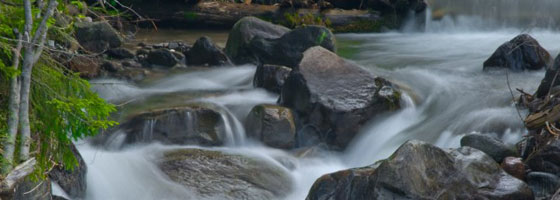River Flow Measurements: Real-Time Solutions

Water level sensors are commonly used in river and stream monitoring applications because they are cost-effective ways to estimate real-time river flow measurements. The river or stream’s level can be used with a water flow rating curve to estimate flow continuously. Level is measurable either with a pressure, bubbler, or non-contact radar sensor.
What is river flow?
Volumetric flow rate measures the speed at which a volume of water in a river is travelling downstream (often reported in cubic feet per second). When flow rate increases, water has a greater ability to erode its channel and banks. More and heavier sediment can be carried by the river, which increases the river’s turbidity.
Making River Flow Measurements
The volumetric flow rate of water (discharge) is commonly estimated from the measured water-surface elevation (stage) using an empirical fit to measurements of stage and concurrent discharge. This is referred to as the stage-discharge relationship, or stream rating.
Measuring the changes in water level over time is only one component to developing a stage discharge relationship. In order to obtain a good estimate of flow, point discharge measurements should be taken periodically to establish and maintain a good rating curve. Each discharge measurement is correlated to the water level at the time the measurement was taken. With this information, discharge data can be interpolated and applied to the full range of water level measurements.
Point discharge measurements in wadeable streams can be obtained using a handheld velocity meter mounted to a wading rod. The SonTek FlowTracker is one such instrument commonly used by government organizations such as the U.S. Geological Survey. In non-wadeable stream environments, a more sophisticated stream discharge measurement system is often required. Towable Doppler velocity systems mounted on either a boat or Trimaran are commonly used to measure discharge in these situations.
Level Sensors
Pressure Sensors
There are two basic kinds of pressure sensors: absolute and vented.
 An absolute pressure sensor, such as the In-Situ Aqua TROLL 200, measures the combined pressure exerted on it by the atmosphere and the head of water above it. In order to determine only the water’s pressure, absolute sensors must be paired with a nearby barometric sensor. The barometric pressure is then subtracted from the absolute sensor reading to obtain accurate water pressure information. On the other hand, a vented pressure sensor, such as the NexSens AccuStage Vented Water Level Sensor, automatically corrects for changes in barometric pressure and does not need a barometer.
An absolute pressure sensor, such as the In-Situ Aqua TROLL 200, measures the combined pressure exerted on it by the atmosphere and the head of water above it. In order to determine only the water’s pressure, absolute sensors must be paired with a nearby barometric sensor. The barometric pressure is then subtracted from the absolute sensor reading to obtain accurate water pressure information. On the other hand, a vented pressure sensor, such as the NexSens AccuStage Vented Water Level Sensor, automatically corrects for changes in barometric pressure and does not need a barometer.
For each of these types, the sensor is fixed below the minimum expected water level, and a cable containing the sensor signals connects to a data logger. Cables for vented sensors also carry a vent tube. The pressure sensor is the most common type of stream gauge sensor because it is relatively cost-effective to install and maintain.
Bubbler Sensors
 Bubbler sensors, including the OTT Compact Bubbler Sensor, measure the water level by detecting the pressure required to force an air bubble through a submerged tube. The pressure is proportional to the water level. A bubble tube runs from a shore-mounted air compressor or air tank to a surface water orifice in the stream. The orifice is fixed below the minimum expected water level and diffuses the air bubble into the water. Damage from debris and floods is minimal with bubblers, as the bubble tubing and orifice are relatively inexpensive. Bubbler systems offer high accuracy and do not drift over time.
Bubbler sensors, including the OTT Compact Bubbler Sensor, measure the water level by detecting the pressure required to force an air bubble through a submerged tube. The pressure is proportional to the water level. A bubble tube runs from a shore-mounted air compressor or air tank to a surface water orifice in the stream. The orifice is fixed below the minimum expected water level and diffuses the air bubble into the water. Damage from debris and floods is minimal with bubblers, as the bubble tubing and orifice are relatively inexpensive. Bubbler systems offer high accuracy and do not drift over time.
Each kind of level sensor presents its own series of tradeoffs. What’s important is determining the sensor that best meets the individual application needs of a specific project. For assistance determining the most appropriate and cost-effective solution, contact a Fondriest Environmental application engineer via e-mail at customercare@fondriest.com or call (888) 426.2151.
Image Credit: http://www.flickr.com/photos/lafaske/ / CC BY-SA 2.0





ken squiers
May 30, 2015 at 5:36 pm
I am trying to compute how many people a stream or small river could
support based on this data: river width is 20 feet, depth average is
8 inches, and a cork takes 32 seconds to travel 50 feet. Help?
Thank you.